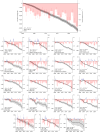Community estimate of global glacier mass changes from 2000 to 2023
- PMID: 39972143
- PMCID: PMC11903323
- DOI: 10.1038/s41586-024-08545-z
Community estimate of global glacier mass changes from 2000 to 2023
Abstract
Glaciers are indicators of ongoing anthropogenic climate change1. Their melting leads to increased local geohazards2, and impacts marine3 and terrestrial4,5 ecosystems, regional freshwater resources6, and both global water and energy cycles7,8. Together with the Greenland and Antarctic ice sheets, glaciers are essential drivers of present9,10 and future11-13 sea-level rise. Previous assessments of global glacier mass changes have been hampered by spatial and temporal limitations and the heterogeneity of existing data series14-16. Here we show in an intercomparison exercise that glaciers worldwide lost 273 ± 16 gigatonnes in mass annually from 2000 to 2023, with an increase of 36 ± 10% from the first (2000-2011) to the second (2012-2023) half of the period. Since 2000, glaciers have lost between 2% and 39% of their ice regionally and about 5% globally. Glacier mass loss is about 18% larger than the loss from the Greenland Ice Sheet and more than twice that from the Antarctic Ice Sheet17. Our results arise from a scientific community effort to collect, homogenize, combine and analyse glacier mass changes from in situ and remote-sensing observations. Although our estimates are in agreement with findings from previous assessments14-16 at a global scale, we found some large regional deviations owing to systematic differences among observation methods. Our results provide a refined baseline for better understanding observational differences and for calibrating model ensembles12,16,18, which will help to narrow projection uncertainty for the twenty-first century11,12,18.
© 2025. The Author(s).
Conflict of interest statement
Competing interests: The authors declare no competing interests.
Figures







References
-
- Bojinski, S. et al. The concept of essential climate variables in support of climate research, applications, and policy. Bull. Am. Meteorol. Soc.95, 1431–1443 (2014).
-
- Haeberli, W. & Whiteman, C. in Snow and Ice-Related Hazards, Risks, and Disasters (eds Shroder, J. F. et al.) 1–34 (Elsevier, 2015); 10.1016/B978-0-12-394849-6.00001-9.
-
- Hopwood, M. J. et al. How does glacier discharge affect marine biogeochemistry and primary production in the Arctic? Cryosphere14, 1347–1383 (2020).
-
- Ficetola, G. F. et al. The development of terrestrial ecosystems emerging after glacier retreat. Nature632, 336–342 (2024). - PubMed
-
- Bosson, J. B. et al. Future emergence of new ecosystems caused by glacial retreat. Nature620, 562–569 (2023). - PubMed

